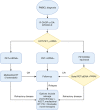Biology and therapy of primary mediastinal B-cell lymphoma: current status and future directions
- PMID: 30740662
- PMCID: PMC6594147
- DOI: 10.1111/bjh.15778
Biology and therapy of primary mediastinal B-cell lymphoma: current status and future directions
Abstract
Primary mediastinal B-cell lymphoma (PMBCL) is a distinct disease closely related to classical nodular sclerosing Hodgkin lymphoma. Conventional diagnostic paradigms utilising clinical, morphological and immunophenotypical features can be challenging due to overlapping features with other B-cell lymphomas. Reliable diagnostic and prognostic biomarkers that are applicable to the conventional diagnostic laboratory are largely lacking. Nuclear factor kappa B (NF-κB) and Janus kinase/signal transducers and activators of transcription (JAK-STAT) signalling pathways are characteristically dysregulated in PMBCL and implicated in several aspects of disease pathogenesis, and the latter pathway in host immune evasion. The tumour microenvironment is manipulated by PMBCL tumours to avoid T-cell mediated destruction via strategies that include loss of tumour cell antigenicity, T-cell exhaustion and activation of suppressive T-regulatory cells. R-CHOP (rituximab, cyclophosphamide, doxorubicin, vincristine, prednisolone) and DA-EPOCH-R (dose-adjusted etoposide, prednisolone, vincristine, cyclophosphamide, doxorubicin, rituximab) are the most common first-line immunochemotherapy regimens. End of treatment positron emission tomography scans are the recommended imaging modality and are being evaluated to stratify patients for radiotherapy. Relapsed/refractory disease has a relatively poor outcome despite salvage immunochemotherapy and subsequent autologous stem cell transplantation. Novel therapies are therefore being developed for treatment-resistant disease, targeting aberrant cellular signalling and immune evasion.
Keywords: haematological oncology; malignant lymphomas; non-Hodgkin lymphoma; tumour biology; tumour immunotherapy.
© 2019 The Authors British Journal of Haematology published by British Society for Haematology and John Wiley & Sons Ltd.
Figures


References
-
- Aaronson, D.S. & Horvath, C.M. (2002) A road map for those who don't know JAK‐STAT. Science, 296, 1653–1655. - PubMed
-
- Abdul Razak, F.R. , Diepstra, A. , Visser, L. & van den Berg, A. (2016) CD58 mutations are common in Hodgkin lymphoma cell lines and loss of CD58 expression in tumor cells occurs in Hodgkin lymphoma patients who relapse. Genes & Immunology, 17, 363–366. - PubMed
-
- Aoki, T. , Izutsu, K. , Suzuki, R. , Nakaseko, C. , Arima, H. , Shimada, K. , Sasaki, M. , Takizawa, J. , Mitani, K. , Igarashi, T. , Maeda, Y. , Ishida, F. , Niitsu, N. , Ohmachi, K. , Takasaki, H. , Nakamura, N. , Kinoshita, T. , Nakamura, S. & Ogura, M. (2013) Novel prognostic model of primary mediastinal large B‐cell lymphoma (PMBL): a multicenter cooperative retrospective study in Japan. Blood, 122, 638.
-
- Aoki, T. , Shimada, K. , Suzuki, R. , Izutsu, K. , Tomita, A. , Maeda, Y. , Takizawa, J. , Mitani, K. , Igarashi, T. , Sakai, K. , Miyazaki, K. , Mihara, K. , Ohmachi, K. , Nakamura, N. , Takasaki, H. , Kiyoi, H. , Nakamura, S. , Kinoshita, T. & Ogura, M. (2015) High‐dose chemotherapy followed by autologous stem cell transplantation for relapsed/refractory primary mediastinal large B‐cell lymphoma. Blood Cancer Journal, 5, e372. - PMC - PubMed
Publication types
MeSH terms
Substances
Associated data
- Actions
- Actions
- Actions
- Actions
- Actions
- Actions
- Actions
- Actions
- Actions
- Actions
- Actions
- Actions
- Actions
LinkOut - more resources
Full Text Sources
Research Materials

